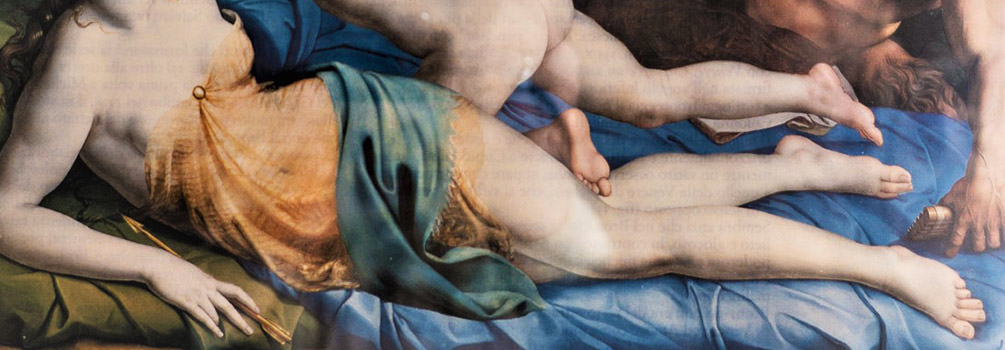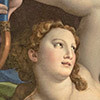In order to better understand the artist's intention, we must travel back in time to Florence, to the court of Duke Cosimo I de' Medici, and to the Academy of Florence and eavesdrop on the ongoing literary and philosophical debates, in which the topic of love played a significant role. This closed-off, elitist world discarded that which was banal, looking for intellectual and esthetic excitement in art filled with allegories, symbols, and meanings hidden in mythological figures brought back to life. These musings are filled with riddles that are meant to awaken a world of fantasy and check the intellectual and emotional preparation of the recipient, coming from the reading of philosophical and poetic works. The members sought topics that were refined and stimulated the imagination. Elegance, wit, irony, the way of speaking, and expressing one's thoughts in a veiled and ambiguous method, all of these were praised. Agnolo Bronzino played a significant role in this community. He was not only the court painter of the de' Medici family but also an ambitious poet. And it was this subtle veil of poetry that covered his painting, more often than not coloring it with shades of irony and sarcasm.
Unfortunately, we are not familiar with the original title of the painting, therefore we are unable to fully understand its message. However, we can be certain that the subject of Venus and Cupid, which was very popular in the times of Cinquecento, was of exceptional significance to the artist since he had undertaken it no less than three times. The most famous painting, which is also considered the most charismatic of Bronzino's works (Venus, Cupid, Folly, and Time), is found in the London National Gallery. Another, much simpler, is a painting from the Budapest Szépművészeti Múzeum (Venus, Cupid, and Jealousy). In all three paintings, Venus is the main protagonist and she is accompanied by Cupid (Amor). Other figures, often quite numerous, supplement the story of the meeting, in which the goddess of love seems to be teasing her companion, at the same time disarming him.

However, let us move on to the painting itself. We see Venus: she has just taken Cupid’s bow away, and she is holding one of his arrows in her hand, meaning this arrow will no longer strike anyone. And while Cupid is wielding yet another arrow in his hand, he is directing it at the sky, as if he was suggesting that he would no longer stir up trouble and is trying to reach love which is located high above our heads and hearts. Why then is he looking at Venus in a slightly mocking fashion, while the goddess herself – as if unsure of his gesture – returns his look full of skepticism? And then suddenly a Satyr (half-man, half-goat) "jumps out" of the bushes, and he seems to be about to seize Cupid's arrow with his large hand. The other hand, leaning on Venus's bed is holding a Pan flute, his indispensable attribute, an instrument that is used for seduction. This is so, because the music, similar to wine, awakens and ignites love.
Venus appears to us, as a majestic, cosmological deity. Even the Greeks knew her two embodiments, which the people of the Renaissance often recalled in the musings on the subject of love. The earthly Aphrodite awakened corporeal love, the heavenly one – stimulated higher values: friendship and spiritual love. The idea of love extending beyond the boundaries of earthly pleasures, one that is selfless, loyal, and friendly, taken from Plato, appeared in the works of Petrarca and Castiglioni, but most of all in the texts of the founder of the Academy of Florence – Marsilio Ficino, as early as the XV century. And it was he who contributed to the formation of the concept of Platonic love – pure, lofty, and bereft of sensuality.
The mythological Cupid, marked with a youthful vigor, a prankster, is depicted as an unstable figure, but most of all dangerous. He struck with his arrows, regardless of age, and ignited the fires of passion. The Greeks, even considered him a troublemaker, who disrupted the social order, since with him he brought pain, anguish, and suffering. He was a type of a demon, an intermediary between people and the gods. However, Socrates claimed that he could be an ally of man, helping him to achieve perfection. In the Tuscan poetry of the late Renaissance he often appeared – either as a cunning god or a capricious child with the wings of a bird. In our painting Venus renders Cupid helpless taking away his power and thus putting an end to sensual, unbridled love. In spite of the Satyr – a personification of the forces of nature and fertility, who seems to be unhappy with such behavior. He was always linked with the male sexual drive. In antiquity, he was often shown with an erect penis. On Bronzino's canvas, his physical desires are depicted by a wild grimace, a stuck-out tongue, and disheveled hair.

Who will emerge victorious from this duel – the delicate Cupid or the lewd Satyr? Is the author trying to show us that all of Venus’s and Cupid’s struggles are for naught, in face of earthly desires? Or perhaps just the opposite? Perhaps it is the Satyr who is destined to be defeated faced with the powers of these two, convinced of the triumph of pure, Platonic love?
The bodies of the divine couple, Venus and Cupid, are pale, bright, and flawlessly beautiful, they seem to be the protagonists of this show. As Plato claimed, and Ficino agreed with him, beauty, including the beauty of the human body, brings us closer to God, allows us to get to know and admire the perfection of his being; is a kind of intermediary between the earthly world and God, is an integral way of getting to know him. However, in all this beauty of figures and elegance, which is presented in this scene, one cannot help but notice a large dose of comedy. The unrestrained Satyr, with a grin signaling: “I am here”, introduces a bit of mockery and derision into the scene, of this ideally understood love, qualities which were often visible in Bronzino’s poetry. Perhaps the work was a courtly jest – and intelligent burlesque on the subject of love?
The painting was commissioned by Alemanno Salviati – the uncle of the Duke of Florence, Cosimo I. It found its way into the Roman collection of the Colonna family in 1718, along with the dowry brought by Zeffirina Salviati when she married Fabrizio Colonna. In 1755, along with other “indecent”, in the opinion of the owner, works it was ennobled, which meant painting ethereal robes, covering the bosom and the breasts of Venus. This was revealed by a conservation project carried out in 2002, which freed the goddess of her robes, also uncovering the colorful beauty of this canvas.
Venus, Cupid and the Satyr, Bronzino (born Agnolo di Cosimo di Mariano Tori), 1550–1555, oil on wood, 120 x 250 cm, Galleria Colonna, Palazzo Colonna
If you liked this article, you can help us continue to work by supporting the roma-nonpertutti portal concrete — by sharing newsletters and donating even small amounts. They will help us in our further work.
You can make one-time deposits to your account:
Barbara Kokoska BIGBPLPW
62 1160 2202 0000 0002 3744 2108
or support on a regular basis with Patonite.pl (lower left corner)
Know that we appreciate it very much and thank You !


























